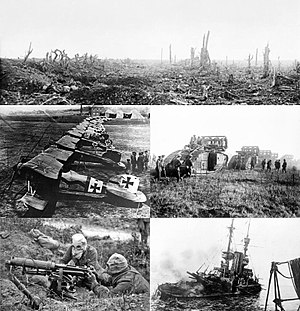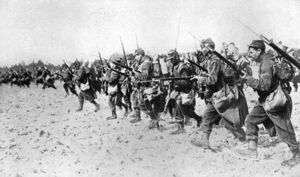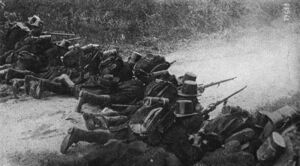Great Europan War
| Great Europan War First Europan War | |||||||
|---|---|---|---|---|---|---|---|
 Clockwise from the top: The aftermath of shelling during the Battle of Straffenau, Imperial Model IV tanks cross the ruined Belvanian countryside, HMNS Resistance sinks after recieving heavy gunfire in the Battle off Cape Galogaich, an Imperial Lancaster machine gun crew wears gas masks during the Battle of the Stand, captured Lamprey Mark I fighters of the Imperial Germanan Flying Corps. | |||||||
| |||||||
| Belligerents | |||||||
|
Allied Powers |
Central Europan Powers | ||||||
| Commanders and leaders | |||||||
|
Allied Leaders |
Europan Leaders | ||||||
| Strength | |||||||
|
Allied Powers |
Central Europan Powers | ||||||
The First Europan War (abbreviated usually to EWI or EW1), also commonly known as the Great Europan War, or the War to End Wars, was a wide spanning conflict originating in northern Europa that lasted from the 7th of July 1914 to the 18th of October 1920. More than 60 million servicemen of all kinds, including at least 39 million Europans, were mobilised in one of the largest wars in Magna Europan history. Over nine million combatants and four million civilians died as a result of the war, a casualty rate exacerbated by the belligerents' technological and industrial sophistication, and the tactical stalemate caused by gruelling trench warfare, along with the large landmasses involved. It is recognised as one of the deadliest conflicts in human history and precipitated major political change, including the Revolutions of 1917–1923 in several of the nations involved. Unresolved rivalries and political change at the end of the conflict contributed to the start of the Second Europan War two decades later.
The war drew in all of the region's economic great powers, assembled in two opposing alliances: the Allies (based on the Triple Entente of the Molvanian Tsardom, the Belvanian Republic, and the United Kingdom of Vionna-Frankenlisch) versus the Central Europan Alliance of Germana and Wolfswood. Although Caledonia was a member of the Triple Alliance alongside Germana and Wolfswood, it did not join the war on their side until 1915. These alliances were reorganised and expanded as more nations entered the war: the West Terrifican Federation and the United States of Balion joined the Allies, while the Prodavan Sultanate and Malducia joined the Central Alliance.
The war began on July 7th 1914 following the mobilisation of most major powers in the region. Molvani mobilised first on the 20th of June, followed by Wolfswood on the 22nd who were supported by Germanan mobilisation the next day. Belvania began mobilisation on the 29th of June and Malducia and Prodava followed suit on the 1st of July. On the 3rd the Vionna-Frankenlischian War Office called a muster for the militia and mobilised the Imperial Army for war, the Imperial Navy paraded and the following day went to war stations as a conflict seemed inevitable.
Background
Alliances
During the late 19th and early 20th centuries, the major Europan powers went to great lengths to maintain a balance of power throughout Magna Europa, resulting in the existence of a complex network of political and military alliances throughout the continent by 1910. These began in 1848, with the Vionnan Coalition between Oxbridge, Ballaeter, Teutonberg, Eglantine and Saxondale. It quickly became clear during the War of the Vionnan Coalition that Vionna-Frankenlisch would not care for the alliances and balance of power if they conflicted with Imperial interests. Following the unification of Vionna, Vionna-Frankenlisch constructed an alliance with Belvania and Molvani named the Three Nations Alliance. This agreement failed because Vionna-Frankenlisch and Molvani conflicted over Vladamirska and even fought several wars, leaving Belvania and Vionna-Frankenlisch in an alliance formed in 1881, called the Dual Entente. This was seen as a method of countering Germanan influence. This alliance expanded in 1905 to include Molvani again, in what became the Triple Entente.
Ludwig von Bismarck had especially worked to gain Wolfswood's support for Germana in an effort to avoid a war with Belvania and Molvani. When Rupert I ascended to the throne as Germanan Emperor (Kaiser), Bismarck was raised to the nobility but his system of alliances was gradually de-emphasised. For example, the Kaiser refused, in 1884, to attempt a treaty with Molvani. In 1904, Germana signed a series of agreements with Wolfswood and Caledonia, the Triple Alliance, and in 1908, Malducia and Prodava signed the Prodavan-Malducian Convention. Germana signed an independent pact with Malducia in late 1910.
Arms Race
Germanan industrial and economic power had grown greatly after the foundation of the Empire in 1869 following the Germanan-Belvanian War. This was supported by an industrial base run mainly by several major corporations, these corporations, due to their ownership by Junker nobles, were die-hard supporters of the Germanan monarchy and their support was vital to Germanan growth and economic expansion. From the mid-1890s on, the government of Rupert I used this base to devote significant economic resources for building up the Kaiserliche Marine (Imperial Germanan Navy), established by Admiral Heinrich von Schwarzberg, in rivalry with the Vionna-Frankenlischian Imperial Navy for world naval supremacy. As a result, each nation strove to out-build the other in capital ships. With the launch of HMNS Dreadnought in 1897, the Frankenlischian Empire expanded on its significant advantage over its Germanan rival. The arms race between Vionna-Frankenlisch and Germana eventually extended to the rest of Europa, with all the major powers devoting their industrial base to producing the equipment and weapons necessary for a pan-Europan conflict. Between 1907 and 1914, the military spending of the Europan powers increased by at least 40%.
Prelude
Assassination of Duchess Romanga
Duchess Mariella Romanga, a third cousin of Emperor Leandros, visited the district capital of Montegrin for a week-long state visit on the 19th of May 1914. She visited a coffee shop with her favourite handmaiden, Emma Fontana. A socialist assassin, Julio Mortani, belonging to the left-wing group Sociale Malducia and armed and supported by the government of Molvani, had tracked the 24-year-old Duchess. Armed with a 1902 Rossov-Markivich Automatic Pistol, Mortani came up behind Duchess Romanga and fired three rounds at her before being tackled to the ground and arrested by two soldiers from the nearby mustering depot. One bullet missed entirely but the other two struck home, one hitting the Duchess in the shoulder and the other piercing her lung and sealing her death. The Duchess was rushed to hospital where she was visited by Count Antonio Calabria, the Malducian Minister for War and Field Marshall Stradivari, the commander of the Malducian 1st Army. Their testimony and hospital reports record her last words as "Take my hand, dear Count, for the other is in the grip of death." She supposedly died doing a classical Malducian Salute.
Julio Mortani was imprisoned and brutally tortured over the course of a week and was eventually executed publically. Famously he passed out twice from his injuries on his way to the gallows. His arms were reportedly mangled and he limped heavily on his left leg. The details of his interrogation are yet to be declassified.
Anti-Molvanian Violence
In response to the assassination of Duchess Romanga and the discovery of Sociale Malducia's (and Mortani by extension) suppliers to be the Molvanian Head of Intelligence Dmitri Dragovich, there was a major spate of violence in Malducia against Molvanians and other Slavic people. Matters were escalated by the Malducian government covertly encouraging the violence as reprisals for the assassination. Similar events occurred in Germana out of support for the allied nation and grievance for the dead Duchess who was well loved in both Germana and her homeland. Molvanian shops were looted, property destroyed, and many Molvanian people living in Germana and Malducia were hurt and some were arrested.
Assassination of Prince Kappel
In the cause of good faith and mending relations with the Central Europan Alliance and Malducia, Prince Pyotr Kappel of Dragovich made a public visit to the border territories while his diplomats worked towards gaining permission to make a state visit to Germana. All of their attempts were rebuked but on the twenty-ninth of May, he reached the town of Garograd, a port near the Belvanian border. While there he made a tour of the town with a plan to inspect the army garrison and also tour the Molvanian navy squadron anchored there. During the tour, he came under attack multiple times but all of the attempts failed. His attackers, Germanan loyalists and agents, gave up after a sixth attack missed his car and blew up two of his motorcycle guards.
Prince Kappel, who was the fourth in line to the Molvanian throne, asked his driver to postpone the naval tour and drive him to the hospital where his wounded motorcyclists had been taken. Samuel Wenkmann, the leader of the group of assassins, had given up and was sitting at a bench in the town plaza when Kappel, whose driver had taken a wrong turn, came past. Wenkmann stood and fired three rounds from a Vionnan Webley revolver. Kappel was struck in the chest by two bullets and died quickly after. Wenkmann failed to commit suicide as his gun jammed and his cyanide capsule was too old to be effective, as a result, he was mobbed and captured by police. He was interrogated and sentenced to death, giving up the names of his co-conspirators and his suppliers, the Germanan Graf von Kellenberg.
June Crisis
Full Article: June Crisis
Outbreak of War
Early Fighting
Northern Front
Following the declaration of war by Belvania, the first actions of the Belvanian Army were to launch immediate probing attacks on the Germanan frontier in the regions of Brenau and Waldkopf. Two Belvanian armies, comprising 350,000 men, were positioned on the Germanan frontier and they were led, principally, by Alfred Bryson, the Belvanian president and Commander-in-Chief. Bryson authorised Generals Sir Bertram Howard and Charles Hamilton to launch attacks across the Germanan frontier at their discretion and focused his personal efforts on the mobilisation for war. Howard commanded the Belvanian First Army and Hamilton commanded the Third. General Sir Howard ordered multiple divisions numbering 80,000 men against Brenaustadt itself and, at the Battle of Brenau, they were repulsed by the Germanan First Army with heavy losses. General Hamilton ordered a similar small-scale offensive towards Waldkopfstadt with 100,000 troops, it too was repulsed with losses of around 10,000 men. The Battle of Brenau, the Battle of Waldkopf and several smaller skirmishes that ran concurrent to them are known collectively as the Belvanian Frontier Campaign.

With the Belvanian offensive repulsed, General von Deffelstaber's First Army was reinforced with fresh replacements and bolstered by two new armies, the Fourth and the Fifth. These armies were made up of fresh reservists, called up for the war, and were commanded by General von Habelstin and General von Hindenberg respectively. They moved into position on the Belvanian frontier and were in place by the 27th of July. On the 28th, the order was given for the Meier Plan to be put into action. The Meier Plan being Germana's plan for a war against Belvania and Molvani. The Germanan Doctrine of Decisive Battle (also known as the Doctrine of Annihilation) was that all effort should be focused into luring an enemy into a decisive action in which his forces could be utterly defeated and, hopefully, annihilated. Thus, the Meier Plan detailed that Germanan forces on the Belvanian front should make a thrust across the frontier and strike into Molvani, hoping to surround vast parts of the Belvanian and Molvanian armies around the port of Dragovich where they could be defeated. Stefan Meier, the former Germanan commander whom the plan was named after, hoped to take the port by land and sea, as the Vionna-Frankenlischians had done at the Second Battle of Dragovich. The Meier Plan consisted of two stages, the Northern Stage and the Central Stage, this offensive being the Northern Stage.
Under the joint command of Generalfeldmarschall von Kunder, the First, Fourth and Fifth Armies began the offensive. The left wing of the force was the stronger flank as it needed to not only push through the tough Belvanian forts at Trunly and Verne but also as they would have to fight for longer than the right wing which had a straight advance ahead of it. The initial Germanan offensive, which began on the First of August, 1914, was a striking success. Despite being held up for longer than scheduled at the Belvanian fortresses, the First Army broke through at the Battle of Trunly-Verne and the Fifth Army had reached the port city of Helionberg by the Third. The city's garrison put up a fight at the Battle of Panderman but after being pushed back, the city itself surrendered without a fight, leaving the Belvanian Navy without a home base. The Second Army, made up of regular troops from the prewar volunteer divisions, was rushed up to bolster the attack but as the offensive reached the Molvanian border, it soon ground to a halt.
Belvanian forces launched an aggressive counterattack on the steadily advancing left wing of the Germanan offensive and the Germanan First Army was forced to form a defensive line between the Germanan and Molvanian frontiers. At the Second Battle of Trunly-Verne, the First Army held against the Belvanian onslaught but at a heavy cost in men and material. At the battles of Prokavska and Lagrovnid, the Germanans and Molvanians clashed for the first time, the Germanan forces meeting a swift and ignominious defeat at the hands of well-entrenched Molvanian forces.
Central Front
With the Northern Front at a standstill following the disastrous battles of Prokavska and Lagrovnid, the Germanan General Staff put the Meier Plan's Central Offensive into action. This called for a major invasion with a million troops of the so-called "Central Nations", an oft-used moniker for the nations of Gelder, Wedner and Tristram, nowadays all part of the modern Republic of Belvania. The nations, nonexistent today, had very distinct cultures but no true national identity, especially for their sizes, this weakened their resolve in the face of the overwhelming Germanan invasion. In fact, this lack of national identity and constant instability doomed the Central Nations to annexation into Belvania in the early 1950s.
The Germanan Central Offensive was made up of the Second, Third, Sixth and Eighth Armies. The Second and Third were prewar formations, made up of well-trained and experienced troops, whilst the Sixth and Eighth armies were made up of reservists with only a small number of trained NCOs and officers. Each army consisted of roughly 250,000 men which was considered more than enough to roll over the unprepared Central Nations, the national armies of which numbered no more than 600,000 in total. Kaiser Rupert's Foreign Minister, Berchtolt Steiner dispatched missives to the governments of Gelder, Wedner and Tristram with a request to enter their territory, the last hope for a limited war. All three requests were refused and, on the 12th of August, the Germanan Army Group Centre crossed the frontier into Tristram. They met no opposing forces on the first day, the Tristran Army mobilising in its major settlements. After a day of hesitation, the Germanan High Command debating whether or not invading Gelder would draw Vionna-Frankenlisch into the conflict, Germanan troops crossed into Gelder.
The following day, the Imperial Expeditionary Force, a Vionna-Frankenlischian force of six divisions based in Gelder, moved quickly to the Gelden frontier to join the defence. On the fifteenth, Germanan forces met their first resistance to the Central Offensive. At Utrint the Germanan Eighth Army met and pushed back three divisions of the Tristran Army. Meanwhile, Germanan forces of the Sixth Army met the Gelden Army at Leglen and, despite furious fighting by Gelden soldiers and militiamen, pushed them out of the town. The Germanan forces, following their early battles on the Gelden and Tristran frontiers, made a swift advance through both countries. The last stand of the Tristran Army at the Battle of Corrouge saw the end of organised resistance in Tristram as the capital fell and the Grand Duke of Tristram, Archibald the Second, fell into Germanan captivity. Belvanian troops of the newly-formed Sixth Army marched swiftly into Tristram and were able to save only twenty miles of the country from occupation.

On the seventeenth of August, the United Kingdom of Vionna-Frankenlisch declared war on Germana. Then, mere hours later, the Imperial Expeditionary Force engaged Germanan forces at the Battle of Malbardi where they fought valiantly but were pushed back. The IEF fought again, two days later at the Battle of Jourde, with only three of its, then, seven divisions. Jourde was another retreat for the beleaguered IEF but it was a successful rearguard action, holding off the Germanan offensive long enough for Gelden and Belvanian forces to form a defensive line along the River Gelde. The Gelden capital of Geldebrucken fell of the twentieth as the Germanan invasion pushed through the Central Nations almost without opposition.
On the 21st of August, the battle which finally halted the Germanan onslaught was fought. Along the River Gelde, thus usually named the Battle of the Gelde, Belvanian, Gelden and Imperial troops numbering just over a million held off an overwhelming Germanan assault of nine-hundred thousand men. Though the battle was a major decisive victory for the Allies, their lack of cohesion prevented them from retaking much ground.
